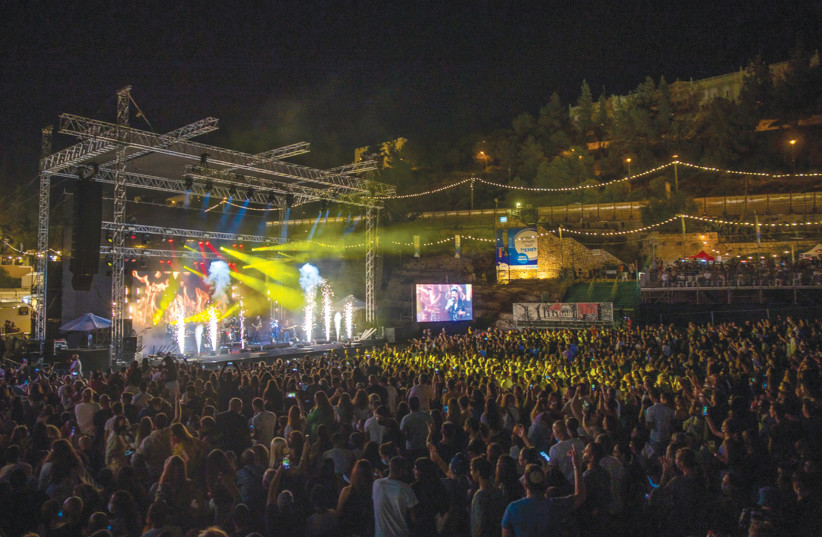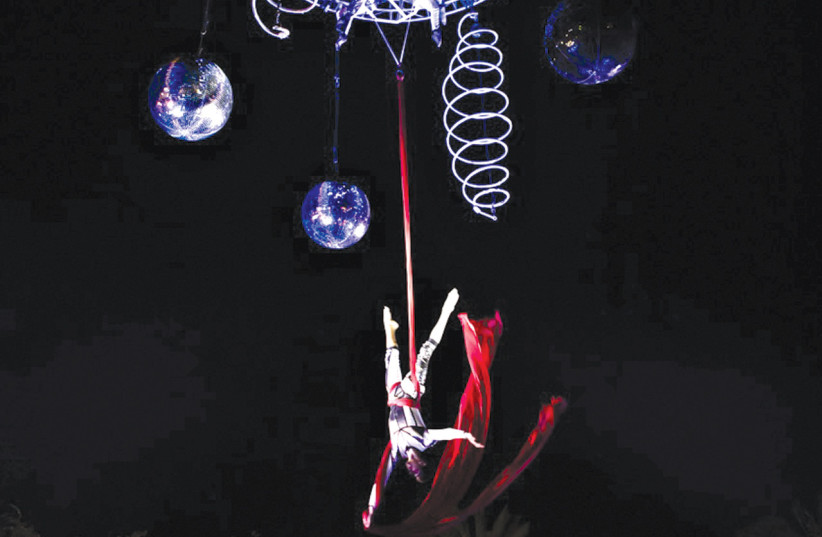History, religion, tradition – when tourists flock to Jerusalem, it isn’t usually to visit its lesser-known arts scene.
However, it’s impossible to miss the Hutzot Hayotzer Arts and Crafts festival, which has been shining the spotlight on Israeli artists and designers for 46 years.
Located in Jerusalem’s historic Artists Colony, which features a collection of ceramicists, Judaica makers, and clothing designers, the festival invites visitors for 10 days of concerts, exhibits, food stands and theater.
This year, the festival will take place from August 15-27, enabling artists to display their wares and some of Israel’s top performers to entertain the crowds at Sultan’s Pool nearby.

An attraction for every liking
The Hutzot Hayotzer festival is known to be the grand celebration of the summer, due in large part to its innovation and diversity of exhibitions. From colorful street theater to interactive photo galleries, the event caters to all audiences in a celebration of Israel’s diverse arts scene.
The exclusive lineup of artists set to perform on stage will begin Monday, August 18, with popular singers Kobi Peretz and Sarit Hadad. On Tuesday, Israeli vocalists Itay Levy and Shlomi Shabat will take the stage, followed by Natan Goshen, Aviv Geffen, Eyal Golan and other popular artists.
There will be a series of exciting attractions available to visitors all day long. Among them is a new exhibition, Artista, which will feature artist Philip Blau’s world of intergalactic characters in a thrilling nighttime adventure.
In a combination of dancers, actors and colorful costumes, theatrical performances featuring white, black and gold colors will provide an interactive theatrical production to its spectators.
Furthermore, a circus show titled Sparks, described as a “spectacular musical performance between heaven and earth of dancers and acrobats” will combine levitation, circus and dance to the hymns of music. Three-dimensional photo walls inspired by famous art, a mobile container gallery and light shows are among the other attractions that visitors can expect at the fair.
“This is the biggest art festival in the country,” said Haim Eldar, vice-president of Ariel, the company organizing the festival. “It’s a real happening of art. We bring artists from all over the world. What we want to do is to bring culture and real art to the people who come to the festival – art that you otherwise wouldn’t see in a museum.”
“This is the biggest art festival in the country. It’s a real happening of art. We bring artists from all over the world. What we want to do is to bring culture and real art to the people who come to the festival – art that you otherwise wouldn’t see in a museum.”
Haim Eldar
<br>History of the Artists Colony
The celebration of innovative art, music and culture alludes to one of the most historic locations in which it takes place: The Artists Colony of Hutzot Hayotzer.
Situated between the walls of the Old City and the Mishkenot Sha’ananim neigborhood – the first Jewish neighborhood outside of Jerusalem – the Artists Colony acts as a gateway between western and eastern parts of the city.
Hutzot Hayotzer was founded in 1967 by Teddy Kollek, the celebrated first mayor of reunified Jerusalem. Honoring the name of one of the great builders of Jerusalem – shared only with kings Solomon, Hezekiah and Herod – Kollek established the Jerusalem Foundation, which took on numerous renovation projects throughout the city.
Among the projects was the village of designers created as a “bridge of peace” in Jerusalem’s sacred city – a place where designers and art lovers could unite as their city finally had.
“Thousands of visitors stream to Hutzot Hayotzer to delight in and engage artists from the world over, during this festive experience,” states the Artists Colony’s website.

Artists’ points of view
However, some artists of the colony have felt as though the bridge that connects them to Jerusalem’s art scene has been left behind among the exciting commotion of the festival.
If there’s one commonality shared among the designers of the Artists Colony, it’s that they would like to participate in the festival, but have had difficulties doing so.
“Most of the action is not here in our area,” explained Shlomit Mandelkern, a ceramicist who has been in the colony for two years. “So, I am still trying to figure out a way to attract more people here.”
Mandelkern has worked as a pottery designer all over Jerusalem. Now, she wants to give visitors to the colony a different artistic experience in her bright and airy studio.
“I want to have a dialogue with people that come. I want to give them an artistic experience rather than just coming to the fair to do shopping,” she said. “Nothing wrong with shopping... but the arts is a big part of the colony.”
Difficult and costly access to the main street of the colony, different crowds and limited spaces are some of the other issues brought up by the artists.
Ayelet Ram, of designer boutique Noa and Ayelet, has been designing wedding and evening dresses for 16 years. However, she has only been in the colony for one year. Her participation in last year’s festival has inspired her to continue showcasing her work at the fair.
“In last year’s festival, my sister, Noa, and I took clothes and dresses, a big roll-up sign and many business cards. We ended up giving away about a thousand of those. It didn’t increase business, though, because we didn’t have a buchan (a table to put everything) and that’s the problem.”
Ram explained that his year’s high demand had denied them the opportunity to display their dresses. “We didn’t know that to be in the festival you must pay money for a small place and just yesterday, we heard that all the spaces had been filled up. We can’t be in the festival, and it’s sad because it’s beautiful and good for our business.”
“Most artists come specially to participate in the festival,” noted Eldar. “Only some from the colony get a buchan. But the fact that we have new artists coming is what makes the festival unique.”
Other artists, who have worked for years to proliferate designer-client relationships with their loyal clientele, believe that there is a strong disconnect between their work and the crowds drawn into the festival.
Some also expressed concern over the yearly occurrence of the festival, mentioning that people are simply not aware that the artists are there year-round.
“The colony has existed here for 55 years, since 1967,” Ram said. “And it’s a beautiful part of the history of Jerusalem.”
<br>Local love for local art
However, for most people displaying, and the patrons, the festival is a peak of their summer in Jerusalem. There is a large communal aspect surrounding the yearly festival, according to Brian Blum, a loyal attendee of the festival.
“You always run into people you know and that’s the great thing about Jerusalem. Being so small and interconnected – despite the fact that there are 1 million residents – the festival is a great opportunity to connect to our community,” he said.
Blum, who has been going to the Hutzot Hayotzer festival almost every year since 1985, looks forward to attending the festival for its concerts and Israeli artwork.
“We love the feeling of being outdoors on a warm summer night, looking at really interesting arts and crafts from great designers,” he said.
Although the fair is divided into two parts, one for international design and the other for Israeli, Blum loves to show his support by buying local art at the festival. “We always look forward to seeing the Israeli art,” he said.
Although he admits to only recently discovering the performances and art openings that occur in the colony outside the dates of the festival, he has amassed an interest in exploring its artists all year round. “In the past couple of years, I have liked going to Kol HaOt, one of the galleries in the colony,” he said. “There are always interesting performances, art openings and expositions available.”
Eldar invites everyone interested in the festival to participate, even if it’s something that travelers might not have included in their itineraries. “A big part of Jerusalem is its culture and artist culture, of course,” he concluded. ❖
